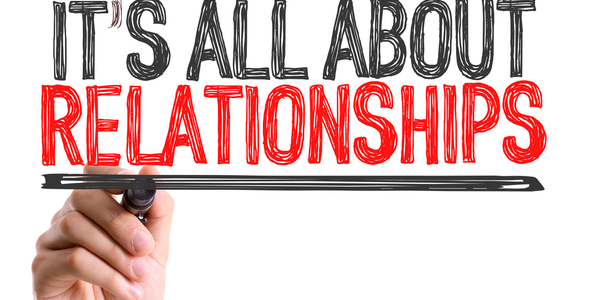7 Quantum Leap Strategies For Revolutionary Relationships
Love is the medicine for the sickness of mankind. We can live if we have love.
—DR. KARL MENNINGER, American psychiatrist
Think about the books and poetry you have read, and the movies and television programs you have seen. What force is almost always at work? It’s the struggle to love.
Relationships venture into the heart. A relationship touches the very center of what it means to be human, but when we choose to open ourselves up, we risk being hurt. Loving makes some people feel out of control.

Imagine that only two emotions exist: love and fear. Once you get rid of fear, there is only love left.
Look around you. How many unhappy partnerships do you see? How many people do you know who are seeking a nurturing, loving relationship? Why is it so hard?
Many of my friends have discovered A Course in Miracles, created and published by the Foundation for Inner Peace, which teaches that all communication is either a loving response or a cry for help. Imagine how your perception of communication and relationships would change if you were to incorporate that simple statement into your belief system.
Begin Your Revolutionary Relationship Journey With Unconditional Love
Seeing the world through the filter of love melts away negativity. If someone confronts you, your gentle response would eventually override your attacker’s anger. That would indeed be a miracle. It would also be magic.
Do you want to be right, or do you want to be happy?
— DR. GERALD JAMPOLSKY, Love Is Letting Go of Fear
When we were in school we learned if you got good grades, you would be loved; bad grades, you wouldn’t. It’s no wonder that love is confusing. We’ve been conditioned to love those who are good and do good things, ourselves included. If expectations are not met, love is threatened or withheld. Love becomes conditional.
Unfortunately the map we use to determine how love works is often marked with false information and erroneous assumptions. Nevertheless, it’s the only map we have.
Here are 7 Relationship Strategies You Can Use
Imagine that only two emotions exist: love and fear. Once you get rid of fear, there is only love left.
1. Love Yourself First
In Edmond Rostand’s play Cyrano de Bergerac, the title character says, ‘‘I long ago made the decision that in every area of life, I will choose the path of least resistance in this, that I will please at least myself in all things.’’ This was Cyrano’s reply when asked why he should refuse to compromise his principles for anyone. When you do what feels right for yourself, you have integrity. Put yourself at the top of the list of people for whose happiness, joy, health, and well-being you are responsible. You are the only person who can dictate what makes you happy.
This does not mean being self-centered or narcissistic. When you nurture a healthy relationship with yourself, you create the foundation for other loving relationships. The more you forgive yourself for your shortcomings, the easier it is to forgive others for theirs. There are enough hurdles to challenge a relationship without adding the strain of your own neediness and desperation.
Hans Selye, researcher and author on stress, used the term altruistic selfishism. He asserts that before we can take care of anyone else, we must take care of ourselves. It’s only a small leap to realize that in order to love others, we must first love ourselves. How can you give what you don’t have?
2. Acknowledge Your Fears About Love
The idea of committing to a relationship or the feeling of being in love can tap into some of your most basic fears. If you associate fear with relationships, go through the following exercise:
- Go into your most relaxed state.
- Imagine telling someone you love him or her or imagine being told that you are loved.
- Feel the fear fully with all your senses. Do you feel more than one fear? If so, see if you can discover the basic fear that supports the other fears.
- Give the fear a shape, form, color, and texture. Describe it as fully as you can.
- Accept the possibility that you have created the fear.
- If you can create fear, you can create fearlessness, too. Create a fearless relationship in your imagination. How would you like it to look and feel? What images and emotions come to mind? What circumstances exist in your visualization? What words would you use to describe your ideal relationship?
- Surround yourself with your ideal relationship. Live it. Breathe it. See it. Feel it. Open your heart. Visualize it, then visualize it again.
- Record in your journal, in the greatest of detail, the exact picture of your ideal relationship. As you write, become aware of any resistance.
3. Accept People as They Are
People sometimes enter a relationship believing that the other person will change, that one partner will be able to influence the other’s behavior. That is a surefire formula for failure.
Instead, respect the needs of the individual in your relationship. Take the time to discover the core values of your partner and make sure those values are honored.
Confrontations are an integral part of the dynamics of any meaningful, committed relationship. The healthy solution is for both individuals to express what they want and need and to confront the situation. With any power conflict, clear and precise negotiation is the only solution.
Accept responsibility for the way you feel and ask for what you need. Often your partner hasn’t a clue that he or she has hurt your feelings or irritated you. You need to ask for what you want in a way that doesn’t cause a defensive response:
‘‘I’m sure you didn’t mean to hurt me, but I feel hurt.’’
‘‘I know you’re busy, but I need to spend some time with you.’’
‘‘When you said that, I was hurt and I know that wasn’t your intention.’’
4. Tell the Truth
HONEST COMMUNICATION IS THE BASIS OF ALL LOVING, HEALTHY RELATIONSHIPS.
Honesty can be very uncomfortable. It’s easier to confide our deepest upsets and hurts to our barber, hairdresser, or mechanic than it is to the ones we love.
Avoid the Accumulation Effect. It is easy to let little irritations and resentments slide. We don’t want to hurt people’s feelings, we don’t want to look foolish, and we don’t want to make a mountain out of a molehill. However, not communicating what may appear meaningless has what I call the Accumulation Effect. The pressure builds as the little frustrations accumulate until there is an explosion of emotion. Whatever caused the explosion is seldom the real reason.
If one too many raindrops fall on a leaf, the leaf gives way, unable to support the weight of the rain. In a relationship, the drops of small hurts accumulate, and the slightest irritation can trigger the Accumulation Effect. Arguments happen that have nothing to do with what has just occurred but have everything to do with what has been stored up from the past. Angry words are exchanged that may permanently damage the relationship.
All this could have been avoided had there been healthy communication.
MAJOR PROBLEMS IN RELATIONSHIPS CAN BE AVOIDED BY INSTANTLY COMMUNICATING WHAT MAY APPEAR TO BE SMALL PROBLEMS.
5. Share the Bad as Well as the Good
Upon returning from a speaking engagement late one night, I received a horrible shock. The daughter of one of my closest friends had left a message on my answering machine that her mother had passed away that afternoon.
Although she lived three thousand miles away, she had been part of my life for thirty years. She was both friend and mentor. Throughout the night, I kept waking up with feelings of profound loss and deep sadness.
I called the daughter the next day. My friend had been very ill for some time and she didn’t want to let me know because it would have worried me. I hung up the phone, hurt and disappointed. I hadn’t had the chance to say good-bye. Not only did I feel left out, but I didn’t have the opportunity to support my dear friend during her illness. I wasn’t able to be at her bedside when she died, which may have given her comfort.
When it comes to close partnerships, the bad must be shared with the good. The good and the bad make up the whole.
6. Renew Relationships on a Consistent Basis
When a relationship is in its formative stage, both parties spend a great deal of time talking. They give unexpected gifts, bring flowers, and send cards. They treat potential partners with respect, listening to problems, sharing, being empathetic. Then something peculiar begins to take place.
As the relationship matures, we begin to expect certain behavior. We criticize more, show appreciation less, get angry more easily, have less patience, and spend less time listening. We forget what brought us together in the first place. The arrogance of assumption sets in: We believe our partner will be there forever, regardless of what we do or say.
Relationships take work. Make it a daily practice to think of all the shared values that brought you together in the first place. Treat your partner as a friend. Respect and value that friendship on a consistent basis. Take the time to listen. Take the time to do the thoughtful little things that made a difference at the beginning of your relationship.
Take the time in the morning or before you go to bed to renew that respect. Give that extra hug. Have the extra patience. Take a few moments to ask how your partner is doing/feeling, and then listen.
Look at a partnership as a team. The sum is greater than the parts. When two people form a commitment, a metaphorical third person is formed. The energy and chemistry of the two form a synergistic third party that needs as much nurturing as does each of the parts separately.
7. Have Fun
Playfulness is an important part of any relationship. Just as you must schedule time to be alone, you must also schedule time to play. Enjoy each other. After all, why did you choose the relationship in the first place?
Follow these 7 QUANTUM LEAP STRATEGIES FOR QUALITY Revolutionary Relationships and you will take the quality of your life to a new level.
IMAGINE THAT!
Delve deeper AND become a Quantum Leap Thinker. Read James’s bestseller, “Quantum Leap Thinking: An Owner’s Guide to the Mind.”
“Your book has rekindled the dying embers of commitment. They now burn majestically out of control.”
– Sylvester Stallone, Actor
AND…
IMAGINE THAT! Igniting Your Brain for Creativity and Peak Performance
This is the first web-supported book with access to 21 video-coaching clips. Please go to the home page www.jamesmapes.com , read the description and you will find the direct link to Amazon.
“Your ability to focus your imagination, manage your thinking, love, and be loved determines your success and happiness more than any other factor. IMAGINE THAT! Igniting Your Brain for Creativity and Peak Performance opens your mind and heart in a beautiful, intelligent and inspiring way.”
— Brian Tracy, Author, No Excuses: The Power of Self-Discipline and Million Dollar Habits

James Mapes is the founder of Quantum Leap Thinking™, creator of The Transformational Coach™, expert on the psychology of “applied imagination,” best-selling author, highly acclaimed business speaker, consultant, seminar leader and personal excellence coach.
